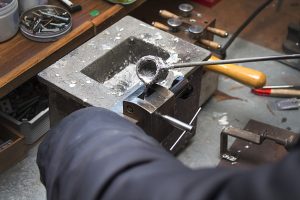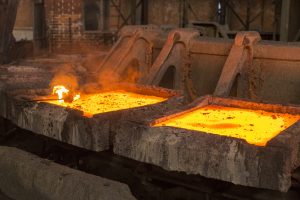Melting Point of Metals
Melting Point of Metals
Knowing the melting points of different metals is important for fabricators and welders. Metals melt gradually, as the metal absorbs heat. Well before a piece of metal reaches its complete melting point, it may begin to soften and warp. To keep things simple, we generally classify the melting point of a metal as that point where it has become fully liquid (called liquidus).
When joining metals with very different melting points, such as copper and steel, brazing might be a better choice than welding. In brazing, an oxy-acetylene torch is used to heat a filler metal, typically a brass alloy, which has a lower melting point than the two metal parts. As the filler melts, it’s drawn into the joint, and then solidifies when cooled. The two parts being joined never reach their melting point, which means that the joint is not permanent.
Welding and Brazing
Welding is the process of joining two sections of metal by heating both parts to their melting point, creating a liquid melt pool in which their molecules mix completely. A third metal filler is often added to the melt pool. When the molten metal cools and solidifies, the two parts are fused completely with an unbreakable bond.

Knowing which metals can be welded, and choosing the best metals for welding, may depend partly on their melting points – if they differ by a large amount, one of the sections will melt faster than the other. This could cause a blowout or other mechanical weaknesses.
When joining metals with very different melting points, such as copper and steel, brazing might be a better choice than welding. In brazing, an oxy-acetylene torch is used to heat a filler metal, typically a brass alloy, which has a lower melting point than the two metal parts. As the filler melts, its drawn into the joint, and then solidifies when cooled. The two parts being joined never reach their melting point, which means that the joint is not permanent.
The following list of melting points of common metals and their alloys ranges from lowest to highest (note that the melting point will vary depending on the exact alloy composition):

Lead has one of the lowest melting points of any metal at 621 F (327 C).
Aluminum
has a relatively low melting point of 1218 F (659 C). When alloying metals are added to aluminum, its melting point can range widely from around 848 F to 1230 F (453 C to 666 C). Adding aluminum to other metals also tends to lower their melting points.
Bronze
: 1675 F (913 C). Bearing bronze contains mostly copper, plus lead and zinc, bringing down its melting point to 1790 F (977 C). Silicon bronze is a low-lead brass alloy that is generally composed of 96% copper plus a small percentage of silicon. Its melting point is 1880 F (1025 C).
Brass: 1700 F (927 C) Brass is an alloy of copper.
Copper
: 1981 F (1083 C)
Cast iron
: 2200 F (1204 C)
Steel
: 2500 F (1371 C)
Stainless steel
: 2750 F (1510 C)
Nickel:
2646 F (1452 C)
Wrought iron: 2700 F (1482 C)
Iron
:2800 F (1538 C)
Tungsten
has an extremely high melting point of 6150 F (3399 C) which is why it’s used for TIG welding electrodes.
Industrial Metal Supply carries a wide range of metals, as well as welding equipment and supplies. Visit one of our six locations or order online today.


